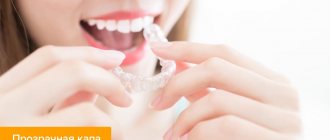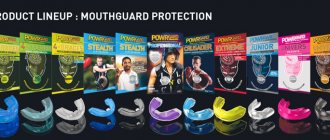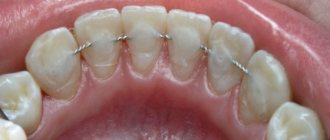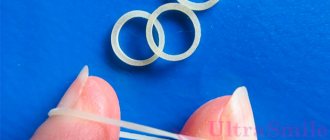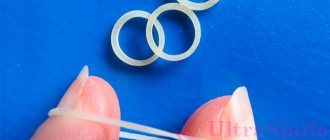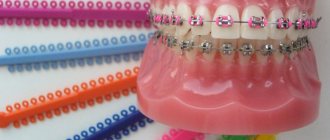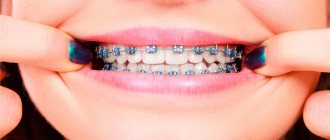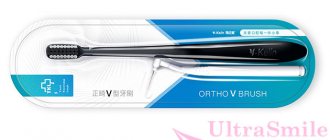Why do you need a dental guard after braces?
Braces correct the bite. This may take several months or even years. When the orthodontic appliance is finally removed, the patient experiences relief. But not everyone knows that after removing braces, teeth can return to their previous incorrect position. This is due to the structural features of the jaw and the physiology of the body, for which it is natural to resist outside interference.
In this article
- Why do you need a dental guard after braces?
- Types of removable mouthguards
- Advantages and disadvantages of removable aligners
- How is an orthodontic mouth guard installed?
- How long do you wear mouthguards after braces?
- How to care for aligners after braces?
- How to wear mouth guards after braces without damaging them?
- Conclusion
In order to prevent repeated curvature of teeth and to maintain the effect of bite correction achieved during orthodontic treatment, the orthodontist prescribes the patient to wear retainers. These are special structures that are worn during the retention period - a time when there is a risk of the tooth returning to its usual position. Retainers hold the teeth in the desired position and allow the ligaments to “get used” to the new bite.
Retainers are removable and non-removable. The latter are wires fixed on the inside of the teeth. A more convenient and popular option is a removable orthodontic mouthguard - after braces, it is worn only at night.
If there is strong bite resistance, the orthodontist may recommend wearing both removable mouth guards after braces and permanent retainers at the same time. In this case, the wire is worn constantly, and the mouth guard is worn only for a certain time at night or during the day.
Indications for correcting malocclusion with mouthguards
It is obvious that it is impossible to correct all defects of the maxillofacial apparatus with the help of aligners. This course of therapeutic action is indicated in the following situations:
- crowded growth of teeth or their incorrect location on the jaw;
- diastemas and trema (increased spaces between dental units);
- malocclusion;
- defect in the development of the dental arch.
Indications for the need for correction using aligners are determined by the orthodontist of our dentistry during a consultation.
Types of removable mouthguards
Dental mouthguards differ in material, duration of wear, and production technology:
- Standard models are made according to one sample and do not take into account the specifics of an individual bite. Therefore, they are rarely used after braces. These types of trays are often used for teeth whitening.
- Thermally modeled retainers. Their peculiarity is that they take the unique shape of teeth after heating. Such a mouth guard is first placed in hot water and only then put on the jaw.
- Individual models are the most accurate and convenient. They are made according to the individual anatomical parameters of a particular patient based on a cast of the jaw.
According to the period of wearing, mouthguards are available at night and around the clock. The first ones are worn exclusively at night and are used in “mild” cases of bite correction. They are worn around the clock, removed only during meals and before oral hygiene. These models are suitable for correcting severe malocclusions.
According to the material, mouthguards can be made of silicone and bioplastic. Both options are distinguished by good hypoallergenic properties, transparency and non-invasiveness.
Manufacturing process and treatment features
First of all, the patient goes for a personal consultation with his doctor. He must also undergo a complete sanitation of the oral cavity, heal all existing carious cavities and eliminate inflammation.
Only after this does the specialist begin making the mouthguard itself:
- An impression is made of the patient's jaw, from which the doctor can recreate a plaster model of the jaw.
- Next, a 3D model of the correct position of the teeth is created, which the doctor will strive for.
- If the patient is satisfied with everything, you can move on to the next stage.
- It is important to know that the course of treatment requires up to 25 drops. All of them have a specific numbering and must be used sequentially one after another.
Capabilities of the mouthguard
The mouth guard will help cope with the following ailments and abnormalities:
- Very large gaps between the teeth or, conversely, excessive crowding in the row.
- Minor malocclusion.
- A noticeably prominent arrangement of one or more teeth relative to others.
- Loss of teeth due to injury and, as a result, malocclusion.
In addition, mouthguards are often used in childhood, when there is improper eruption of the first and molar teeth.
Mouth guards or braces
First of all, it is worth noting that braces systems will cost the patient much less than mouth guards. However, before making a choice, you should consider several points and understand the differences between these two methods.
Braces are made of durable metal or equally durable ceramics, and mouthguards are made of plastic. As a result of wearing braces, soft tissues may be injured, and the enamel may change its shade. Mouthguards are absolutely safe and non-traumatic.
Advantages of the mouth guard:
- The design is removable, which allows you to clean your teeth and the product itself more thoroughly. This reduces the risk of developing caries.
- Custom-made mouthguard simplifies the installation process. Braces made to certain standards are not suitable for everyone.
- Mouthguards are not noticeable to others.
Despite many advantages, mouthguards, unfortunately, cannot cope with very complex pathologies.
Advantages and disadvantages of removable aligners
Caps have many advantages:
- unlike fixed structures, they can be worn for a limited time;
- using mouthguards after braces is more comfortable, since the jaw “rests” from metal structures;
- Oral care is easier if the retainer can be removed.
The main disadvantage of aligners is that they are a noticeable design that affects appearance, so not everyone is ready to wear such retainers during the day. In addition, the design can cause increased salivation.
The process of “cooking” the mouth guard. Why is this necessary?
The “cooking” process involves adjusting the protective plate to the characteristics of your jaw. As a rule, thermoplastic mouth guards are subject to “cooking”. The packaging of this protective element contains detailed instructions for its preliminary preparation before use.
How is an orthodontic mouth guard installed?
The removable retainer is placed by the orthodontist for the first time; in the future, this can be done by the patient himself. Before the first installation, the doctor prepares the oral cavity for the installation of an orthodontic structure. Checks that the braces system does not damage tooth enamel, evaluates the presence of carious lesions, and covers the teeth with a special protective layer.
A custom-made or thermally modeled mouth guard is placed on the patient's teeth and shown how to remove and put it on independently.
Price for mouth guards for teeth straightening in Moscow
Typically, once patients find out how much Invisalign® teeth straightening trays cost, they begin to look for alternative systems. Be careful! Conventional silicone aligners for teeth straightening are somewhat cheaper, but their effectiveness is also low. It is worth noting that the prices for installing invisible braces attached from the inside and sapphire braces systems are in the same price category, but only Invisalign® teeth straightening trays give a predictable result and provide comfort at all stages of treatment.
The iOrtho clinic network provides high-quality services for correcting malocclusion with Invisalign aligners, sign up for a consultation now!
How long do you wear mouthguards after braces?
The most common question that patients ask their orthodontist is how long to wear mouth guards after removing braces. For each person, the wearing period is individual and determined by the doctor. For some, a year is enough to fix the bite; for others, it takes more than two years. If you want to roughly calculate how long you need to wear mouthguards after braces, you can use this conditional formula.
Take as a basis the time during which you wore the braces system and double it. This will be the approximate period of wearing the mouthguard. Many people wear it for two to four years. But there are also people whose muscle memory “refuses to remember” the new position of the jaw; the process of fixing the bite is very slow. In this case, you may need to wear a mouth guard for a longer period, sometimes for life.
Which mouthguard to choose
When choosing a boxing mouth guard, remember how much a visit to the dentist costs. “Repairing” one tooth will cost more than a good insert.
Production leaders refused to produce double-sided protectors (for both jaws). Therefore, we will not consider them.
Single-sided plates, as you now know, come in one-, two- and three-layer types. Prices for single-layer protectors start from 150 rubles.
A reliable three-layer Everlast mouthguard , with the maximum degree of protection, will cost 1000-1100 rubles.
Read also: Why are pointers needed in C?
Need recommendations from MMA fighters - choose Venum . The defense was created by fighters based on personal experience. With such a boxing mouth guard you can go into the ring. Professional protection costs 1200 to 2500 rubles.
If you want a bright design from British aristocrats, check out Opro mouth guards .
The undisputed favorite remains the brand - Shock Doctor . Three-layer protection, a wide price range, warranty obligations - this is the number one policy.
How to care for aligners after braces?
Oral care when wearing orthodontic appliances should be as thorough as possible to avoid caries and other dental damage. Therefore, when installing retainers, the orthodontist must tell the patient how to properly care for the aligners. Below are basic rules for safe cleaning of orthodontic trays and oral care.
The aligners must be removed twice a day during morning and evening brushing. After removing the structure, you must thoroughly brush your teeth with a brush and paste, clean the interdental spaces with floss, floss or irrigator, and remove plaque from the gums, tongue, and inner surface of the cheeks.
The mouthguard itself is also carefully cleaned with a brush and paste, removing plaque and dirt from it. Once every seven days the structure is treated with a special disinfectant. It is also recommended to use mouthwash more often when wearing removable retainers.
Trainers
The orthodontic trainer can be used in children with primary and mixed dentition
.
The main feature of this device is its functional focus - in addition to a slight correction of the position of the teeth, the trainer effectively influences the formation of nasal breathing, the correct position of the tongue and lips, and eliminates the bad habits of putting the tongue between the teeth, sucking fingers and other objects.
How does the device work?
Silicone two-jaw mouth guard has platforms for the upper and lower dentition, a tongue guard and a lip bumper
.
When a child puts on a mouth guard, the teeth fit into special grooves and the jaw is fixed in the correct position. The tongue guard
prevents the tongue from being between the teeth, which prevents the development of an open bite, and the correct position of the tongue at the roof of the mouth contributes to the development of the upper jaw in length and width.
The lip bumper
ensures proper lip tone and closure and helps eliminate bad habits such as thumb sucking and mouth breathing.
In difficult clinical situations, the trainer is used as pre-orthodontic preparation (stage 1) for treatment with braces or aligners in the future, already permanent dentition (stage 2). The device eliminates bad habits, promotes the harmonious development of the jaws and proper teething, but does not ensure ideal straightness of permanent teeth and does not correct severe malocclusion pathologies.
What types of trainers are there?
Orthodontic trainers come in several standard versions. They differ in size, rigidity, frame, and can have areas for the entire dentition or separate cells for each tooth. The orthodontist selects the size and a specific model depending on the clinical case (LM-activator, Myobrace Starter, Myobrace NoCore, Elastopositioner-corrector, etc.)
When is a trainer appointed?
- bad habits (thumb sucking and other objects, breathing through the mouth, putting the tongue between the lips, etc.)
- slight crowding
- slight narrowing of the dentition
- reverse incisal overlap
- palatal or vestibular position of individual teeth
- Stage 1 of orthodontic treatment
The use of a trainer is contraindicated in case of impaired nasal breathing due to ENT pathologies (chronic runny nose, tonsillitis, etc.)
What is the wearing mode?
The device must be worn regularly and daily . The trainer must be worn at night, and during the day it is enough to wear the device for 2-3 hours, for example, while doing homework or watching TV. At first, the device may put a little pressure on your teeth or fall out of your mouth at night, but with regular use, adaptation occurs quite quickly - after just a week, the trainer will not cause any problems or discomfort. The trainer should not be chewed while being worn and you should not talk to it - this can deform the structure of the mouth guard and its impact will be unpredictable.
Using the trainer for 10 months
Caring for the device
The device must be washed under running water every time after use, and the mouth guard must be washed with soap once a week. The main thing is not to use very hot water and hard brushes, as this can damage the silicone material of the trainer and lead to its deformation.
How to wear mouth guards after braces without damaging them?
Mouthguards are made of plastic material, so they can be easily damaged if handled carelessly. In this case, the device will no longer perform its main task - to hold the teeth in the correct position. If it breaks, it cannot be repaired; a new one will have to be made. Therefore, it is important to follow the rules of safe operation.
How to wear a mouthguard correctly:
- To avoid damage, it must be removed before each meal.
- Plastic aligners do not withstand high temperatures well, so you should not drink hot tea, coffee or other drinks with an orthodontic structure in your mouth.
- Between uses, the mouthguards are worn like other personal care products - in special lockable containers. This protects the device from contamination and damage.
- You cannot smoke with a mouth guard in your mouth, because tobacco smoke and tar change the color and structure of the material. The mouth guard becomes cloudy and less flexible.
- The structure is stored at room temperature. Both heat and cold negatively affect its characteristics.
Check after cooking
Before wearing a mouthguard for training or combat, you should carefully check it to ensure it is ready and free of errors or defects.
The impression must contain dental imprints. This will ensure maximum retention of the guard so that no additional support from the lower jaw is required.
If mistakes were made during the preparation of the mouthguard, then as a result, the tooth marks will be invisible, and the protection will not adhere well to the teeth. Even with a weak finger press on it, you can notice a slight squeeze. In this case, the mouth guard cannot be used until the errors are corrected.
Rules of care
Caring for medical mouth guards is extremely simple - just rinse them every day with plain water and clean the inside with a soft-bristled toothbrush. The main thing is to monitor the temperature of the water, since boiling water can deform the plastic.
Important!
It is strictly forbidden to boil, steam or dry products over hot springs for disinfection purposes. It is also undesirable to drink hot drinks and eat too hot and hard food with a mouth guard in your teeth.
Wearing your mouthguard correctly means keeping it clean and washing it regularly, even if it looks very clean. Microorganisms that can harm your teeth can accumulate inside the plastic. Additionally, it is allowed to use special disinfectant solutions that prevent the formation of plaque.
On a note!
If desired, you can purchase box cases for storing aligners: they are very compact and have small holes for ventilation and maintaining optimal humidity.
Adults and children
Invisible mouth guards have already been appreciated by patients of different ages. However, their invisibility, which is an undeniable advantage for adults, is not always beneficial for children. Especially when it comes to children of preschool and primary school age.
Children and teenagers do not always understand the importance of orthodontic treatment and may remove the onlays whenever they feel comfortable, or rather uncomfortable. Therefore, the responsibility falls on the parents: they must explain what brilliant results can be achieved with the help of a mouth guard if all the orthodontist’s recommendations are followed.
On a note!
Indications for the use of plastic mouth guards are the same for adults and children. They help correct deep bites, remove wide gaps between teeth and “spread apart” teeth that are too dense.
In children, orthodontic mouth guards can be used for muscle training - trainers and LM activators. They are made of silicone and are used at the teething stage to correct primary, mixed and permanent dentition.
Rating of the best caps
Boxing mouthguards from different manufacturers are available for sale, differing in price, purpose, age category and other qualities. Below are the best models of mouthguards from the budget, mid-price and expensive segments:
| Model name | Material | Age category | pros | Minuses | Average price, rub. |
| Ray-sport | thermoplastic | for adults | takes individual shape after cooking | single-jawed | 200 |
| Excalibur 1566 | silicone | for adults and teenagers | Advantages:
| Flaws:
| 300 |
| Everlast 1-Jaw. Single | thermoplastic | for adults and large teenagers | Advantages:
| single-jawed | 350 |
| BN fight blue | gel in solid material | for adults | Advantages:
| given form | 390 |
| FLAMMA Iceman 2.0 | gel | for adults | Advantages:
| not thermoplastic | 800 |
| Venum Challenger WhiteBlack | gel and rubber | for adults | Advantages:
| not thermoplastic | 950 |
| Venum Predator GreyBlack | silicone with gel | for adults | Advantages:
| dark color | 1 700 |
| Everlast EverShield 2 | thermoplastic | for adults | Advantages:
| primitive design | 1 250 |
Experts definitely do not recommend buying mouth guards from the famous sports brand Adidas. This brand, although famous, turned out to be insolvent in the production of protective overlays for teeth.
Anyone who practices boxing should use a mouth guard as a mandatory piece of equipment. By choosing a high-quality product that suits individual characteristics, the athlete not only preserves the integrity of the teeth and jaw, but also saves on the services of an oral and maxillofacial surgeon.
Question to an expert How often do mouth guards need to be changed? Change mouthguards for children according to the anatomical and physiological changes in the jaw and mouth; for adults, when they are worn out. Dental onlays require replacement, for example, after being bitten or improperly cooked.
Purpose of a protective mouth guard
It is necessary to wear a mouth guard for:
- Lip protection. Despite the fact that the product is designed to protect the dentition and jaw, its use also helps to protect the lips. It will not be possible to completely protect them from injury, but the number of lacerations will be significantly reduced.
- Exceptions for cerebral hemorrhage.
- Preventing damage to the trachea from dental fragments.
- Avoiding displacement of the cervical vertebrae.
- Reduce the likelihood of concussion.
Experienced boxers note that a mouthguard should also be used to relieve tension in the facial muscles. This helps to quickly restore balance after missed hits.
Children also need protection - you need to put a mouthguard on your child’s teeth both during training and before serious sparring. A novice athlete must know how to use a mouthguard and how it should fit. Only those parents whose children wear braces will need to seek professional help.
Features of alignment using a mouthguard
To straighten your teeth, you need to visit an orthodontist. The specialist will examine the oral cavity and tell you whether mouth guards can be used. If no contraindications are found, then a three-dimensional cast is made , and then a plaster model and several aligners are created, taking into account individual characteristics. In particularly difficult cases, the kit contains about 30 products.
At the next visit, the first tray is installed, and the rest are given to the patient. During the treatment process, a person replaces the structure every 2-3 weeks. In addition, it is recommended to visit a doctor every 1-1.5 months to monitor the alignment of your teeth.
The duration of treatment directly depends on the degree of deformation of the dentition. In the simplest cases, it will take only 2-4 months to correct the defects, and in complex situations, treatment will take 1-2 years.
Mechanism of action, pros and cons
Mouthguards that correct bites are placed directly on the teeth and cause them to move using gentle pressure. They are practically invisible on the teeth, which is one of the main advantages of these devices. However, it is advisable to wear mouthguards only for minor dental defects.
Transparent aligners are chosen by many patients because they have significant advantages over other orthodontic devices:
- Keep teeth healthy - the enamel does not wear off, does not calcify and is not susceptible to caries. The condition of the enamel does not change in any way while wearing a mouth guard and is absolutely independent of its presence.
- Invisible to people around you - you can see that your teeth are in a mouth guard only from a close distance, less than three steps. For many, this factor is decisive when choosing a method to correct the bite.
- They do not interfere with speech function and do not scratch the mucous membranes of the mouth. The adaptation period is quite easy.
- Simple and easy to wear and care for. There is no need to radically change your lifestyle and give up your favorite foods or adapt to special hygiene procedures.
Before deciding to use mouth guards to straighten your bite, you must take into account their disadvantages:
- High cost. Orthodontic aligners are more expensive the more serious the problem. This involves longer treatment times and therefore more replacement products will be needed.
- The need for self-control and discipline. The effectiveness of corrective mouth guards depends 99% on the time of use: they must be in the mouth for at least 20-22 hours a day, otherwise the mouth guard will not help.
- Alignment trays only work for relatively small deviations in the dental system. Severe deformities and abnormalities of the jaws are treated in other ways, but dental aligners can still be used to consolidate the results.
Wearing results - before and after photos
In 2015, researchers from the US National Institutes of Health conducted an independent study that compared how Invisilign aligners and metal braces work. The scientists concluded that the treatment results were virtually the same.
However, mouthguards are inferior to braces in closing the teeth after correction is completed, which is due to the design features, which completely cover the teeth with plastic or silicone. Specialists are aware of this deficiency and straighten the teeth using elastic rods on aligners.
Therapeutic regimen
For orthodontic treatment, mainly individual mouth guards are used, which are made from dental impressions. First, the patient undergoes an examination by a dentist, who decides on the advisability of installing a mouth guard.
If the decision is positive, the doctor gives a referral for an x-ray, and a plan is drawn up based on the results of the orthopantomogram. Treatment of bite with mouthguards is carried out according to a standard algorithm: an impression is taken from the dentition, according to which a 3D model is built to create an ultra-precise product.
Several removable aligners will be required, which the patient will change himself in accordance with the scheme developed by the doctor. The process is structured in such a way that each subsequent drop is slightly different from the previous one.
On a note!
Before taking impressions, it is necessary to cure all teeth that need it, and, if necessary, carry out healing procedures for the gums and ultrasonic cleaning. The list of recommended activities includes remineralization of tooth enamel.

